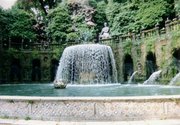Villa d'Este
|
|
Carl_Blechen_007.jpg
Villa_d'Este_01.jpg
The Villa d'Este is a masterpiece of Italian architecture and garden design. Situated at Tivoli near Rome, it is listed as a UNESCO world heritage site.
The Villa d'Este was commissioned by Cardinal Ippolito d'Este, who had been appointed Governor of Tivoli by Pope Julius III. From 1550 until his death in 1572, he created a palace surrounded by a fabulous terraced garden in the late-Renaissance mannerist style.
Drawing inspiration (and much of the marble used for construction) from the nearby Villa Adriana (the palace of Emperor Hadrian) and reviving Roman techniques of hydraulic engineering to supply water to a sequence of fountains, the cardinal created an elaborate fantasy garden whose mixture of architectural elements and water features had an enormous influence on European landscape design.
Pirro Ligorio was commissioned to lay out the gardens for the villa, with the assistance of Thomaso Chiruchi of Bologna, one of the most skilled hydraulic engineers of the 16th century, who had worked on the fountains at Villa Lante. At Villa d'Este he was assisted in the technical designs for the fountains by a Frenchman, Claude Venard, who was an experienced manufacturer of hydraulic organs.
The Villa was celebrated in poetry, painting and music, and is evoked in Liszt's "Les Jeux d'Eaux à la Villa d'Este".
The grounds of the Villa d'Este also house the Museo Didattico del Libro Antico, a teaching museum for the study and conservation of antiquarian books.
See also
History of gardening: Tiburtine Sibyl
External link
- Villa d'Este - Official Site (http://www.villadestetivoli.info/)de:Villa d'Este

